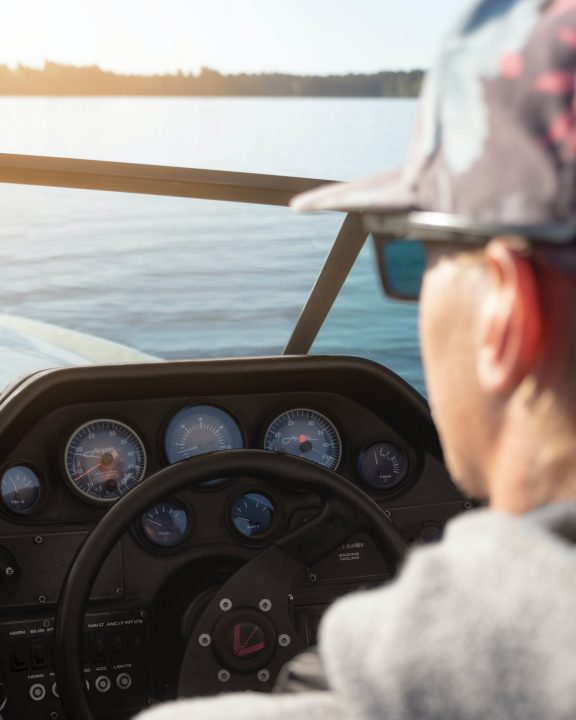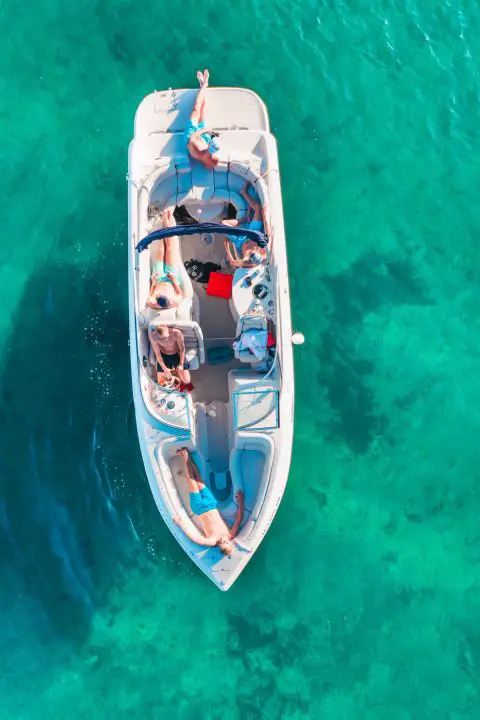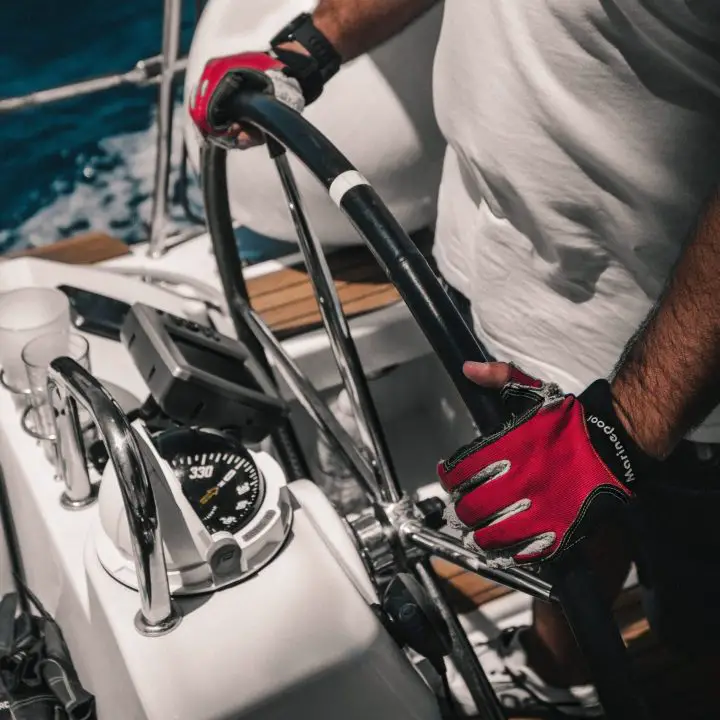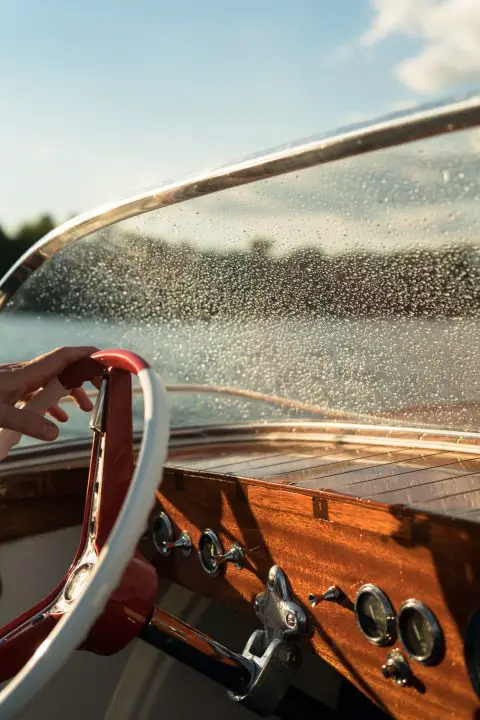In different countries, cars steer on different sides of the road. For example, in the U.S., cars drive on the left, and the driver’s seat is on the left-hand side. In the U.K., cars drive on the right, and the driver’s seat is on the right-hand side.
However, you might notice that boats across the world have steering wheels on the right-hand side. Boats don’t drive on roads and don’t need to follow strict lanes as cars do. So, why is a boat steering wheel on the right?
Boats were traditionally steered by an oars person who had a steering oar on the starboard (right side of the boat). Nautical traditions are hard to break, so the tradition continued even with advancements in technology.
Table of Contents
- Port and Starboard Nautical Terms
- Why Do Boats Drive on the Right?
- Why Are Boats Right Hand Drive?
- Other Boat’s Steering Wheel Configurations
- Steer Your Chosen Path
- FAQs (Frequently Asked Questions)

Port and Starboard Nautical Terms
Sailors and boaters find the terms “right” and “left” confusing. For example, if the captain is facing aft and asks the helmsperson to “steer left,” is the captain referring to their left or the helmsperson’s left? As such, boaters use the more specific terms “port” and “starboard” terms to discuss the different sides of the boat.
If you are the helmsperson looking toward the boat’s bow, the right side of the boat is “starboard.” The left side of the boat is “port.” If the helmsperson looks behind them, the “starboard” side will be to their left. However, they will refer to this side as “starboard.”
If the captain says “10 degrees starboard”, the helmsperson will know which way to turn. Visit our article on how to remember port and starboard to learn more!
Why Are Boats Steering Wheels on the Right Side?
Centuries ago, before engines and technology, boats were steered by a big paddle or steering oar. The steering oar was mounted on the right side of the boat to make it easy for right-handed people. Because the steering oar was on one side of the boat, the right-hand side became known as steorbord, or starboard.
The starboard side steering paddle was fragile, and captains didn’t want to crush their steering paddles against docks. So, they approached new ports and docked on the left side. This side was called the port side.
To recap, if you are facing the bow, the right side of the boat is called starboard. The left side of the boat is called the port.
Why Do Boats Drive on the Right?
Traditionally, boats were steered by an oars person who had a steering oar on the starboard or right side of the boat. Nautical traditions are hard to break, so the tradition continued even as technology advanced.
Many boats, including most sailboats, have centered steering wheels. It is more space-efficient to have the steering wheel on one side. If a boat has an offset steering wheel, it is nearly always on the right-hand side.
Port to Port Passing Rule
Traditional boats approached docks from the port side to protect their steering oars. In addition, boats preferred to pass each other “port to port.” This means that when a boat is headed towards you, you keep that boat on your port side. Each boat then passes each other from the port side to the port side. In this manner, the steering oar was protected from damage. The steering oar on the starboard side was kept safely away from the passing boat.
While technology has improved and boats no longer have steering oars, they still pass each other “port to port.” International regulations require boats on a collision course to alter their course to pass from port to port.
Why Are Boats Right Hand Drive?
In addition to the nautical tradition of steering the boat from the right side, most people are right-handed. It just makes sense for right-handed people to steer the boat from the right-hand side. It is easier for right-handed people to manage a throttle with their right hand.
Technical Reasons
There are also technical reasons boat manufacturers place the steering wheel on the right-hand side. Propellers turn clockwise and create left-leaning torque. This phenomenon is known as prop walk. Boat designers like to have the heavy steering column on the boat’s right-hand stand to counteract this weight.
Close-Quarters Manuevering
Because of the effects of prop walk, most boats today try to dock on their starboard sides. Boats with a lot of prop walk are easier to manage when favoring the starboard side. Then, as the captain docks the boat, he can also manage lines from the starboard side very quickly. Managing prop walk is a practical reason for right-side steering wheels.
Which Side Has Better Visibility?
Some might argue that one side has the best visibility. For example, if you are steering from the right side, you can see opposite direction traffic approaching from the right side. This might help boaters avoid oncoming traffic and abide by international rules that dictate who has the right of way.

Other Boat’s Steering Wheel Configurations
While right-hand steering is popular amongst a variety of boats, not all boats have starboard steering. A different steering wheel placement can work in different boats. Some powerboats and many sailboats have centered steering wheels. More modern sailboats feature dual steering controls.
Center Console
Some small boats have steering columns right in the middle of the cockpit. These small pleasure crafts are called center consoles and are very popular. Passenger traffic flow is optimum, and the helmsperson has great visibility. In addition, the captain can help with dock lines on either side of the vessel.
Sailboats with Centered Steering
Most sailboats have steering wheels in the center of their cockpits. This keeps the boat balanced, and the helmsperson can steer on either the port tack or starboard tack.
Sailboats With Dual Steering Wheels
Modern types of sailboats, however, can feature dual steering wheels. As a result, sailors can sit on the upwind side of the vessel and enjoy better visibility. Dual helms are often reserved for larger boats, whereas smaller boats usually have just one steering apparatus.

Left Hand Steering Wheel
Many jet boats feature left-hand steering. Because jet boats don’t use traditional props and don’t have prop walk, there’s no technical reason for the steering column on the right side.
Modern jetboat manufacturers have more flexibility in placing the steering wheel. Some manufacturers, such as Yamaha, always place the steering wheel on the right-hand side. Other manufacturers prefer their steering wheels to be on the left side.

Steer Your Chosen Path
There’s a mix of reasons boats tend to have right-side steering. Anglo-Saxon sailors and Vikings steered their traditional boats from the right side. Right-handed sailors prefer to steer and use technical controls with their right hand. Ensuring good visibility is helpful in preventing collisions.
No matter which side you sit on, steering your own boat on the open sea is incredible.
FAQs (Frequently Asked Questions)
Why are boat steering wheels on the right side?
Traditionally, boats were steered from the right, or starboard side, of the boat. Traditional boats were steered using steering paddles. Because most people are right-handed, it made sense for the steering paddle to be located on the right side. In addition to the traditional steering setup, many boats have a left-turning tendency known as prop walk. Having the heavy steering station on the right-hand side helps balance the boat. Captains operating boats with prop walk often find it easier to dock on the starboard side. When the steering wheel is on the starboard side, they have better docking visibility and can easily manage dock lines from the helm.
Why are jet boats left-hand drive?
Not all jet boats are left-hand drives. Jetboat manufacturers like Yamaha produce jet boats with steering wheels on the right-hand side. Because modern jet boats don’t use propellers, they don’t have the left turning tendency issues. Jetboat manufacturers can choose to build their boats with left-hand drive steering or right-hand drive steering. Jet boats are free from traditional boat-building conventions, and some like to buck all traditions and create truly modern boats.

